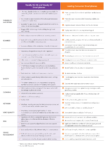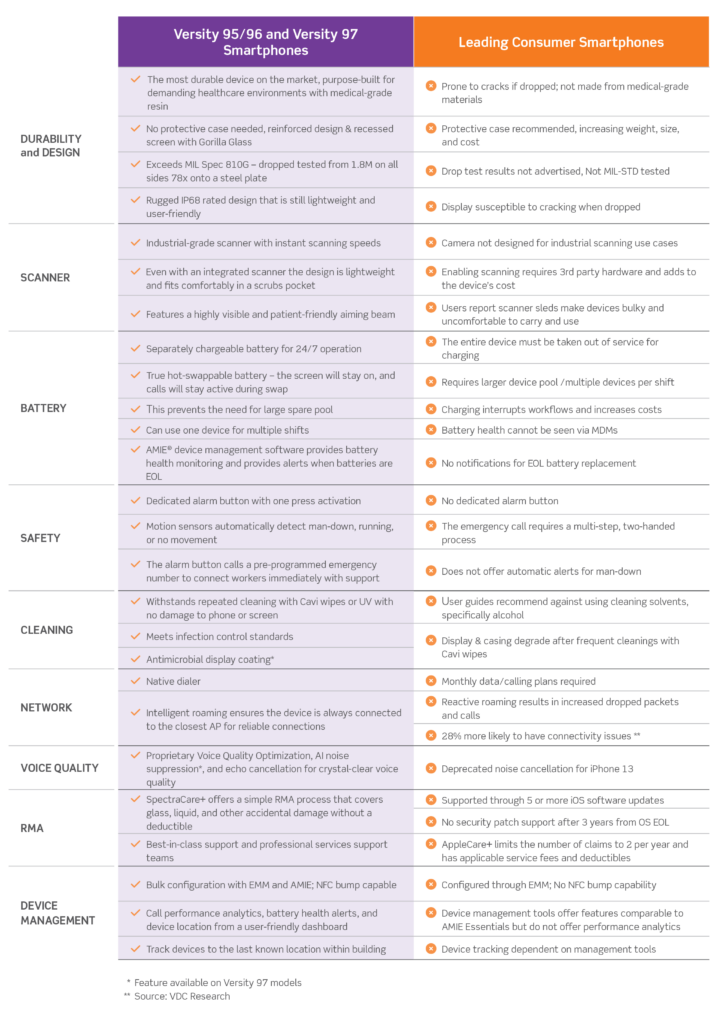Enterprise vs. Consumer Smartphones in Healthcare

Healthcare is a mobile industry. Most healthcare workers in clinical settings move about a healthcare campus to perform the essential functions of patient care. And, no matter where they are within the facility, they need constant access to information to provide the best care to their patients, whether that information is from healthcare records, consulting medical texts, reviewing test results, or collaborating with colleagues. This vast amount of data coming from many different sources needs to be accessible as quickly as possible to ensure the best possible patient outcomes.
Historically, healthcare workers had to rely on many tools and sources located in disparate locations to access this information. Nurses, doctors, and other healthcare staff would have to travel to a patient’s room to review their chart, travel to a nurse station to call the lab for results, wander throughout the facility to communicate with other members of the care team or wait for pages to be answered, and travel to an office to consult medical texts. All of this takes up valuable time for an already over-taxed healthcare staff.
Once information started to become digital with the onset of Electronic Health Records (EHRs), with alarms and alerts coming automatically from patients or equipment, and with medical texts being available electronically, it became much easier for that data to travel. However, access to data still required going to workstations to make calls, wheeling around cumbersome carts from patient room to patient room to access electronic charts, and relying on overhead paging to connect with team members.
The solution? Mobile devices like smartphones were introduced into the healthcare environment. This became a game changer, with healthcare providers able to access any information they need from the device in their pocket, to receive alarms and alerts no matter where they are in the hospital, and to connect with team members on patient care. While this changed the game for healthcare, the actual devices being used by healthcare workers were not quite ready for the workload or the rigorous demands of the fast-paced healthcare environment.
On the surface, using the consumer devices we use every day would seem sufficient and cost-effective for healthcare workers. Consumer devices have a low initial investment cost, and the learning curve is minimal. The cameras are usually high quality, and the app store and built-in web browser means access to any information necessary. However, the stakes in healthcare are too high to rely on a device not designed for the specific demands of a healthcare environment. And, when considering all of the additional costs required to enable a consumer device to perform effectively in a healthcare environment, the TCO (total cost of ownership) soars.
Enter enterprise-grade smartphones purposely built and designed for healthcare environments. The Versity 97 and Versity 95 smartphones are designed specifically for clinicians and demanding enterprise environments like healthcare. These devices feature structural designs and advanced feature sets that far exceed those in consumer devices, while still remaining sleek, lightweight, and easy to use. When capabilities are compared, like durability and design, battery life, voice quality, and more, enterprise smartphones win over consumer devices every time:
 Case Study:
Case Study:
While the spec comparison clearly favors an enterprise device for a healthcare environment, the real-world examples we hear from our customers who converted to Spectralink Versity smartphones from consumer devices solidify the argument for Versity as the premium choice for healthcare.
We recently had a US-based, 450-bed Level 2 Trauma Center convert to Spectralink Versity smartphones after two unhappy years with consumer devices. The three biggest issues they experienced with consumer devices were unexpected additional costs, lack of support and control over the devices, and a lack of critical healthcare workflow capabilities.
Cost
Roughly 600 consumer smartphones were purchased at what seemed to be a reasonable upfront cost, and ongoing management costs began to skyrocket quickly. Because the devices were fragile against the demanding environment, they required protective cases. There was no integrated scanner, so bulky scanning sleds had to be purchased, and additionally, the licenses to use these scanners also had to be purchased. Spectralink smartphones have an integrated scanner that does not require an additional licensing fee. In order to access certain critical sign-on applications on consumer devices, expensive, weighty, and fragile docking boxes and the related software had to be purchased, and the ports in these were fragile, often breaking and requiring support and repair. And finally, because the device batteries could not be charged separately from the device like they can with an enterprise smartphone, twice the amount of devices needed to be purchased in order to accommodate charging and in-use devices.
Lack of Support and Control
The only available technical support offered for the consumer devices was through the purchase of a basic care agreement from the phone manufacturer. Unfortunately, that basic care agreement did not offer the level of support and speed of service required in critical care environments. With Spectralink, we offer multiple levels of support packages to our customers that can be customized according to their needs, upgraded when needed, and ensure fast response times. Additionally, the consumer devices remained on their scheduled update rollouts, regardless of how they might impact how the device was being used in the hospital and ensuring that critical healthcare applications could run uninterrupted or without issue. After experiencing a few situations in which an update rollout from the manufacturer caused critical functionality to cease and a lack of support to get the problem fixed in a timely manner, the hospital telecom and CNIO became increasingly frustrated with the inability to manage rollouts and ensure care would not be interrupted. Additionally, the hospital struggled to locate devices within their building and lost them to theft.
Healthcare Workflow Capabilities
While many healthcare applications will work just fine on a consumer device, there are some critical capabilities that just don’t, like single sign-on and badge tap. Additionally, while processing speeds are fine for everyday use, real-time patient monitoring showed lags. And perhaps the most problematic was the call connectivity. The consumer devices were repeatedly dropping calls or having poor call quality. With Versity enterprise-grade smartphones from Spectralink, this problem was virtually eliminated due to our proprietary Voice Quality Optimization technology and dedicated second antenna to ensure voice is prioritized and critical calls were not missed.
In summary, while smartphone technology has revolutionized the healthcare workflow for busy frontline workers, a specified enterprise-grade technology is required to meet the needs of clinicians, provide access to tools to adequately care for patients, and hold up to the demanding environment. From cost to durability to feature sets to overall user experiences, enterprise healthcare phones like Spectralink’s Versity come out on top every time, and our customers who have had both in their critical healthcare environments have truly experienced the difference and why enterprise mobility solutions are critical.
